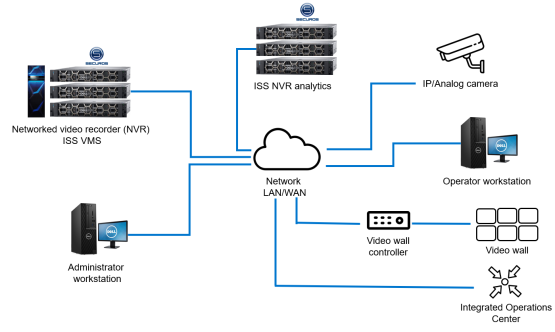Home > Edge > Digital Cities Edge > White Papers > Dell Technologies Video Analytics Reference Architecture with ISS - White Paper > Joint reference architecture
Joint reference architecture
-
The ISS VA on Dell Technologies reference architecture consists of the compute infrastructure as well as the software components to implement the VA algorithms.
Architecture
The following figure outlines the high-level reference architecture of the solution.

Figure 24. Dell Technologies VA reference architecture with ISS
The various components of the architecture include:
- Compute infrastructure for VA
- Accelerator cards for performance enhancement
- ISS SecurOS analytics modules
- ISS SecurOS VMS module (optional)
- Operator workstations
The overall solution is a combination of the VMS and the VA modules that run on a dedicated compute environment. The VMS is validated to use external storage systems to persist the recorded videos. The analytics modules can be either deployed directly on the bare-metal servers or run on a VMware-based virtualized environment. The servers are designed for small to large installations, with large camera and bandwidth requirements. Additionally, the servers are engineered to efficiently run ISS VA modules, and support SAN/NAS expansions. Operator workstations are used to run the client applications for the video playback and incident response capabilities.
In addition to the VA use case outcomes mentioned earlier, the solution also enables the integration of the results into other applications like an integrated operations center (IOC) to help provide seamless situational awareness. This integration leverages the APIs provided by SecurOS to share real-time results with other applications.
The next sections describe the key features that distinguish the solution.
Modular architecture
The scalable architecture of the solution allows operators to easily upgrade to other SecurOS editions and include more modules at any point in time. It is seamless to add new functionalities and capabilities with minimal software management. Expanding to a larger scale of operation is also a straightforward process involving addition of compute servers and leveraging a centralized storage system to store the recordings.
Native failover clustering
Modern IT-systems require the implementation of cluster architectures for flexibility and fault tolerance. SecurOS Native Cluster technology allows operators to build flexible, resilient IT systems. In case of hardware failures, the system’s functionality is restored automatically, and the recovery process is transparent for video surveillance operators.
A resilient server architecture is key to the continuous availability of video recording. If any physical server fails, the virtual SecurOS video server automatically migrates to the standby physical server. SecurOS Cluster supports various configurations, starting with “2+1” configuration (and even “1+1”) and ending with more complicated configurations that may include hundreds of servers. SecurOS Cluster allows operators to create a solution with the required level of redundancy by allocating the right number of cluster servers for backup servers. This eliminates any data loss, security management process shutdown, or video archive loss during the period of work on replacing a failed server.
The failover capabilities include:
- Support of simple “2+1” (2 video servers+1 failover server) to complex configurations, consisting of dozens of servers
- Failover of all ISS features including analytics modules
- Failover operation under 30 seconds
- The ability to assign any SecurOS virtual video server to any physical server.

Figure 25. SecurOS failover clustering
Federation
The SecurOS federation capability scales as required to tie together as few as a handful of sites, up to hundreds or even thousands of globally disparate sites, and provides management of all SecurOS servers within the virtual network and visualization of all cameras and other devices which are connected to each individual SecurOS deployment. It further standardizes security procedures and automates alarms and actions across an organization’s complete security infrastructure for a more streamlined workflow and globalization of security operations. This automation helps make security personnel more productive and better informed.

Figure 26. SecurOS Federation
The flexible SecurOS architecture allows operators to create a hierarchical structure from several MCCs. One MCC can be top-level to other MCCs, or the responsibilities can be divided among several MCCs in accordance with the customer’s needs.
Integration
The SecurOS solution is built as an open architecture platform that allows integration with third-party systems and devices, providing operators with a complete monitoring system. The solution provides an extensive API/SDK toolkit for easy third-party platform integration. Through these integrations, SecurOS can easily share alerts and insights with other applications as well as consume insights and data from external systems.
SecurOS integrates a multitude of ISS and third-party systems into one network and creates a unified command and control capability. All devices, objects, cameras, systems, and even users, macros, and scripts can be individually managed and have multi-level permissions based on login. Each object can be controlled manually or automated using scripts and macros.

Figure 27. SecurOS Integration Structure
The ability to connect the equipment according to ONVIF and RTSP standards expands the list of integrated devices. SecurOS also provides interaction with software products like:
- ERP-systems, PSIMs, other third-party systems including custom-made corporate systems
- Geographic information system (GIS)
- Emergency Service (911)
- Application-dependent software
